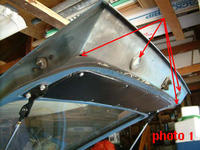
Z's are notorious for leaking exhaust gasses (or fumes) into the interior. This article details a procecss to find and eliminate the sources. To make the article easier to read, key photos are hot linked, while additional views just have a hyperlink you can click on.
When driving with a window open, the air rushing around the windshield and drip moulding creates low pressure in the front half of the open window. This vacuum is what draws the air in the back half of the open window, and ultimately draws in exhaust fumes through any leak near the back of the car. If the windows and doors do not seal well, exhaust is drawn in (to a lesser effect), even with the windows closed. Granted when driving there is a low pressure area over the whole hatch and rear panel of the car, but not nearly as strong as the low pressure formed from an open window. This should also improve heater performance, since you can also find and eliminate high pressure air leaks.
Equipment needed:
To recreate the leaks in a garage, you need:
- A shop vacuum.
- Some cardboard.
- About 3 feet of 1/4" to 3/16" automotive vacuum hose (to act as a stethoscope).
- A roll of masking tape.
- Optionally you can also use a DJ smoke or fog machine (rented from an equipment/party rental facility). It makes finding leak areas easier.
To seal the leaks you need:
- Seam sealer or caulk for tiny leaks (like GE Silicone II in clear and/or black available at home centers).
- Dum Dum (like 3M strip caulk #08578 available at NAPA) or duct seal (like Blackburn duct seal available at home centers) for small to medium leaks.
Depending on where you have leaks, you may also need:
- Spray adhesive (like 3M general trim adhesive #08088) to attach interior vinyl.
- Replacement body plugs, grommets, gaskets and interior trim plastic rivets (from Nissan or aftermarket Z specialists).
The test setup:
If using a smoke machine, Set it on a piece of cardboard inside the hatch compartment (facing rearward) and send the power and remote cords out the passenger window.

Close up of the Smoke Machine:

Test firing the smoke machine...

Open the passenger window about 3" and seal the shop vac floor nozzle to the upper rear corner of the window frame with tape. Cover the rest of the window opening with cardboard, and seal the opening inside and out with masking tape.

Another view:

Turn the dashboard vent control to "Off," and close both fresh air vents under the corners of the dash. The shop vac can now be used to pressurize (hook the hose up to "blowing" port) or depressurize (hook the hose up to the vacuum port) the interior.
The depressurize test:
Close the hatch and driver window, seal the round vents behind the quarter panel windows (if equipped) with tape, hook the shop vac hose to "vacuum," turn it on, get in the car and close the driver door. Feel for air coming in the dash vents and fresh air vents. Either repair the leaks now or temporarily seal them up with tape - these leaks hurt heater performance in the winter.
With vacuum on, feel around the interior with the back of your hand for leaks. Below are some possible leak areas and fixes (fix each leak as you find it (either permanently or temporarily) and it will make it easier to find each successive leak):
-
Hatch seal - check alignment of hatch (adjust hinges & striker), replace hatch seal and/or add additional "universal" weatherstrip to close gap as needed. Even with a new gasket and properly adjusted hatch, I needed to add a strip of "universal" foam to the upper edge of the hatch to get a seal. This image is with the hatch slightly open, showing how the gasket touches the hatch on either side of the hinge, but leaves a gap in the hinge centers.

- Hatch filler panel - remove and add thin universal weatherstrip around underside if leaking from edges, on Series I 240Z's (cars with 2 horizontal chrome vents on the outside of the hatch) if leaking from slots, remove panel and clean / repair vent flaps, on non-Series 1 cars, check the large rubber body plugs on the outside of the hatch about a foot from either side of the latch.
-
Bottom of strut towers - under the diagonals for the strut towers (under the vinyl) there is a 1.5" diameter body hole with no grommet (this is over where the rear diff crossmember mounts to the frame rail). Where the diagonal mounts to the floor is also not fully sealed. All of these holes suck air through the frame rails. Nissan did not plug or seal these holes - the vinyl trim is supposed to seal off area. Either seal the vinyl to the floor, or peel back the vinyl and seal these areas (or do both).

- Tail lamp panel, dome lamp panel & speaker openings - the many possible sources will be checked with the pressurize test. If you remove the interior panels, the fuel tank vent hoses, antenna drain hose & grommet, tail light gaskets, unsealed sheet metal seams, and rust holes are common causes.
- Door or window seals - replace.
- Shifter - replace inner shift boot.
The pressurize test:
On Series 1 cars, seal up the body vents by taping up the slots on the inner hatch trim panel. From outside of the vehicle, close the doors, attach the vac hose to the "blowing" port, and if you have the smoke machine, plug it in and fill the interior with smoke.
Filling up (the smoke does not stain)...

All full...

Turn on the vacuum and look for large leak areas (every Z has lots!).

Feel with the back of your hand, confirming location with the "stethoscope" hose held up to your ear (note that you are doing this at your own risk - I accept no liability if you injure your ear drum, a bug crawls in your ear, of if you forgot the hose was full of some toxic substance). Starting from the rear of the vehicle (again, fix each leak as you find it -- it makes it easier to find remaining leaks):
- Tail lamp vents - (2 on bottom of each tail lamp). Remove felt "filters" if present and seal with clear caulk. The lamp sockets are not sealed, providing adequate ventilation without the outer vents. This should also stop the internal lens discoloration due to exhaust gasses flowing through the lamp.
- Under hatch - The hatch has a thick inner and a thin outer gasket. Any leak between the gaskets draws in exhaust. With the hatch open you can seal the opening with cardboard, taping it to the inner gasket and run a pressurize test or just open the hatch and seal the following:
- Round body plugs on either side of hatch rail.
- Pinch weld above hatch hinges (just below the outer seal along the roof edge) - caulk gaps.
-
Hatch hinges to the body - Seal any gaps (exopsed adjustment or shim slots, seal the hinge gasket to the body, and if a pressure check confirms a leak from inside the hinge pocket, remove the hatch & hinges and seal any splits and cracks inside the rubber hinge pocket seals.
This was a hard to find leak. In this photo, the hatch and hinges are removed. The hinges fit into a pocket along the roof edge. Behind the metal plate is a rubber boot that fits inside and seals the pocket. One of the pockets on this car had a crack deep inside the pocket and an area worn through from rubbing on the hinge. The part is no longer available from Nissan, so some glue and liquid rubber was used to seal it up. The gaskets also sealed poorly to the roof support (caulk sealed it up). There were also numerous leaks between the inner (thick) and outer (thin upper) gasket in the photo. Anywhere two pieces of sheet metal were spot welded together needed caulk.
Continue the pressure test under the car:

In the below photo, many leaks are sealed at this point, allowing the smoke coming from under the driver rear fender to be visible.

Potential under the car leak sources:
- Evap emission hoses & grommets - just behind the rear valence panel - use the stethoscope to pinpoint.
- Seam welds around floor behind rear valence (you may need to remove the fuel tank, or use the stethescope hose to thoroughly check).
- Antenna drain hose and grommet - on driver's side behind wheel well. If lots of air comes out of the hose, it could be disconnected from the antenna or the antenna may need to be sealed. Remove the inner hatch trim panel to check.
- Pinch welds just forward of the antenna drain, and seam welds going back to rear valance panel.
- Evap hoses and grommets on passenger side, behind wheel well.
- Pinch welds just forward of evap hoses and seam welds going back to rear valence panel (removing the splash shield behind the passenger tire may ease access without needing to drop the tank.
- Wheel housing inner pinch weld in front of rear tire.
- Pinch weld under rocker panel (toward rear)
- Round holes under outside rocker panels (these can be plugged with the same rubber plugs used on either side of the hatch rails, and some sealant). Don't seal the oval drain ports in the inside of the frame rails.
- Body plugs in spare tire well and driver and passenger floors.
Rest of car:
- Pinch welds on forward side of gas door opening (upper and lower corners).
- Hatch compartment floor rubber body plugs (remove carpet and check - these lead into the frame rails and can draw exhaust).
- Body plugs behind seats (remove carpet and check - for Series 1 these are in the storage bins). These lead into the frame rails.
- Grommets & throttle rod boot on firewall.
Below are links to additional Exhaust Fume Articles:
- "Solving the Fume Problem in a 280Z" by Zhorse:
- "Exhaust Fumes in 1st Generation Z Cars" by rzola:
Happy hunting... Here's to summer driving without burning eyes and a passed out passenger...
Edit: 2020-06-01 by Mike: Updated all image links and cross posts.








Recommended Comments
Create an account or sign in to comment
You need to be a member in order to leave a comment
Create an account
Sign up for a new account in our community. It's easy!
Register a new accountSign in
Already have an account? Sign in here.
Sign In Now